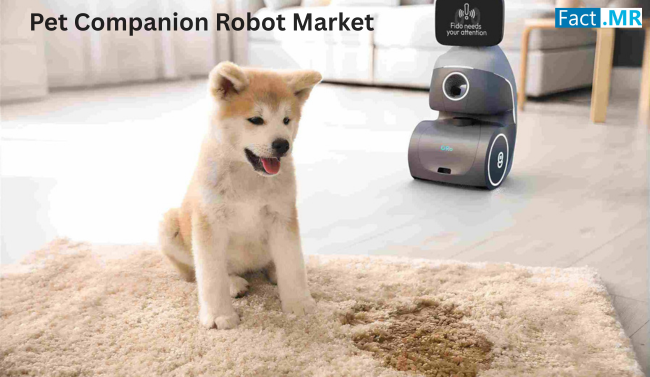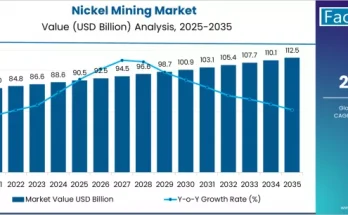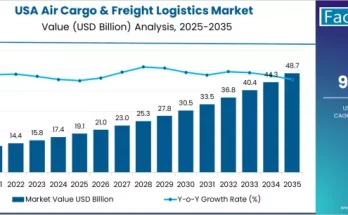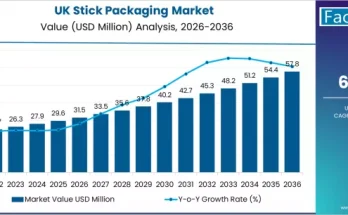As lifestyle trends evolve and technology continues to permeate daily life, a fascinating new category is emerging in pet care: the pet companion robot. These autonomous or remote-controlled robotic devices are designed to alleviate separation anxiety, provide entertainment, monitor pet health, and dispense food or treats—basically serving as tireless, interactive caretakers when owners can’t be present.
According to the latest report from Fact.MR, the global pet companion robot market was valued at US $766.7 million in 2022 and is projected to grow to US $874.5 million in 2023, before expanding at an estimated 12.3% CAGR to reach US $2,865.1 million by 2033. Over the previous five years (2018–2022), the market recorded a solid 8.4% CAGR.
What’s Fueling This Growth?
- Global Pet Boom + Rising Pet Wellness Focus
The COVID‑19 pandemic—and the resulting surge in pet adoptions—ignited both emotional and financial investment in pet companionship. In the U.S., for instance, 70% of households owned a pet as of 2021, up from 68% in 2016. Likewise, in the UK, 74% of dog owners reported their pets experienced anxiety or depression, highlighting a growing awareness and concern around pet mental health. Pet owners increasingly spend on wellness: American pet expenditures totaled US $103.6 billion in 2020, an increase of US $13.1 billion since 2018.
- Busier Lives, More Time Away from Pets
As offices reopen post-pandemic, many pet owners face the challenge of balancing work and pet care. With only about 30% of workplaces allowing pets, robotic sitters are stepping in as practical solutions . These devices provide companionship, dispense treat rewards, and offer remote interaction and monitoring.
- Advances in Robotics & Smart Tech
Cutting-edge developments in AI, IoT, autonomous navigation, sensors, self-charging systems, and voice/video controls are making pet companion robots smarter, more capable, and more accessible. Market leaders like ENABOT (EBO), Samsung (Bixby-powered vacuums), Pebby, Pumpkii, and Guru IoT (PEDDY) showcase this innovation trend.
Market Breakdown: By Type, Application, Connectivity & Region
Fact.MR segments the market across four axes, each showing notable trends:
By Type: Autonomous vs Remote-Controlled
- Autonomous robots dominate, commanding roughly 65.4% market share in 2023, with projected revenue of US $571.6 million.
- Remote-controlled models hold the remainder, popular for direct interaction and user-guided monitoring.
By Application: Feeding, Entertainment, Monitoring
- Feeding robots are the largest category—representing 41.5% of global market share, with over US $363.3 million in 2023. Scheduled, portioned feeding offers pet welfare and convenience.
- Entertainment and monitoring/video recording are increasingly popular, with robopets offering games, streaming, and remote communication.
By Connectivity: Wi-Fi vs Bluetooth
- Wi‑Fi enabled robots enjoy a 43.6% share in 2023 .
- Bluetooth models are gaining traction, with Bluetooth-connected robots reaching approximately US $492.9 million in 2023.
By Region
- North America leads, holding 32.2% of the global market (~US $281.7 million in 2023).
- Europe controls 28.1% (~US $245.8 million).
- China accounts for 12.9% (~US $113.1 million), driven by doubling of pet care spending over the last decade.
- Other regions—Latin America, South Asia & Oceania, MEA—are following suit as pet adoption and tech access increase.
Dynamics Within Key Markets
Dominating 27.7% of the global share, the U.S. leads with US $242.5 million in pet robot sales, driven by high pet ownership and disposable incomes.
China’s pet-care sector has exploded—1,500% growth in ten years, with 32.8% CAGR (2015–2020). China holds over 71.8% of East Asia’s market share.
Countries like the UK, Germany, and France are adopting pets at scale and value welfare-driven technologies, making Europe a strong secondary market.
Challenges Slowing Adoption
- High Price Points
Most pet companion robots retail for hundreds of dollars, competing with cheaper alternatives like treat dispensers, pet sitters, or human care options. - Questionable ROI for Some Users
Not all pets engage with robots beyond treat retrieval, and some even panic when interacting—dampening repeat purchase cycles . - Entry Barriers for Providers
Designing mobile, AI-enabled robots requires advanced capabilities, and regulatory/safety standards can pose additional hurdles. Startups face high R&D costs and need differentiation . - Privacy & Safety Considerations
These devices stream video/audio from inside homes—prompting privacy and cybersecurity concerns. Companies must address data protection and ensure user trust.
Opportunities for Market Expansion
- Modular & Multifunctional Robot Platforms
Robots like Samsung’s AI vacuum and ENABOT’s EBO, which combine home automation and pet care, offer new value beyond specialty niches.
- Wellness-Driven Features
Future robots may feature smart feeding alerts, fitness tracking, hydration reminders, or behavior insights—appealing to wellness-conscious pet owners.
- Swarm or Connected Robot Systems
Imagine multi-robot systems collaborating—one plays, another monitors vitals, a third dispenses food. Connected systems add resiliency and expand functionality.
- Affordability Through Scale and Tiering
Larger manufacturers (like Samsung) can bring down costs. Tiered offerings—from basic monitoring to advanced AI models—can broaden market penetration.
- Localization and Niche Customization
Tailored products for cultural preferences (e.g. cat-focused robots in Japan) or climates could boost adoption. Fine-tuning voice commands or treat preferences is one angle.
- Services + Hardware Bundling
Combining hardware with subscription services—training modules, pet telehealth, remote monitoring—can create recurring revenue and improve engagement.
What Leading Brands Are Doing
- ENABOT (EBO): Autonomous pet companion with smart tracking, treat dispensing, and family interaction features.
- Samsung: Launched Bixby-enabled vacuums with pet-monitoring features—signaling giants entering the pet tech space.
- Guru IoT (PEDDY): Designed for home monitoring, feeding, and health tracking.
- Pumpkii: Modular robot offering entertainment, feeding, and hygiene features.
- Other innovators include Pebbby, Anthouse, DTK, Rocki, Skymee, VARRAM, each competing in entertainment, monitoring, or feeder segments.
Strategic Takeaways for Stakeholders
For Manufacturers & Start‑Ups
- Focus on autonomous feeding and monitoring—the dominant segments.
- Invest in better UX: edge AI, pet-behavior understanding, safety standards, seamless charging.
- Differentiate through modular ecosystems, or add-on service layers (health monitoring, vet alerts).
- Partner with traditional brands (pet supplies, electronics OEMs) to access distribution and credibility.
For Investors
- Look for startups in AI-driven autonomy, multi-robot systems, wellness analytics.
- Support emerging players in affordability innovation—lower-price but feature-rich models.
- Back platform players combining hardware with service-based revenue models.
For Pet Parents
- Evaluate feeding reliability, battery life, treat compatibility.
- Prioritize data security and privacy assurances (local storage, encryption).
- Look for software upgradability, integration with home ecosystems (Alexa, Google, app control).
For Veterinarians & Pet Behaviorists
- Use companion robots as passive monitoring and engagement tools.
- Integrate robots into enrichment programs, particularly for anxious or elderly pets.
- Offer veterinary add-ons—telehealth, activity tracking, and routine compliance.
Conclusion
The pet companion robot market is at an intriguing intersection of emotional need, disposable income, and technological capability. Owners want assurance that their four-legged friends are safe, engaged, and healthy. Robots can fulfill that promise—if their design is thoughtful, reliable, and affordable.
The pace of pet adoption isn’t slowing, and neither is investment in pet well-being. As Fact.MR forecasts nearly US $2.9 billion market potential within a decade, this is a space ripe for innovation, strategic partnerships, and services that care just as much about pets as their human families do.
If you’re an entrepreneur, investor, or animal lover, the time to explore pet companion robotics is now. This isn’t just play—it’s a technological embrace of empathy.



